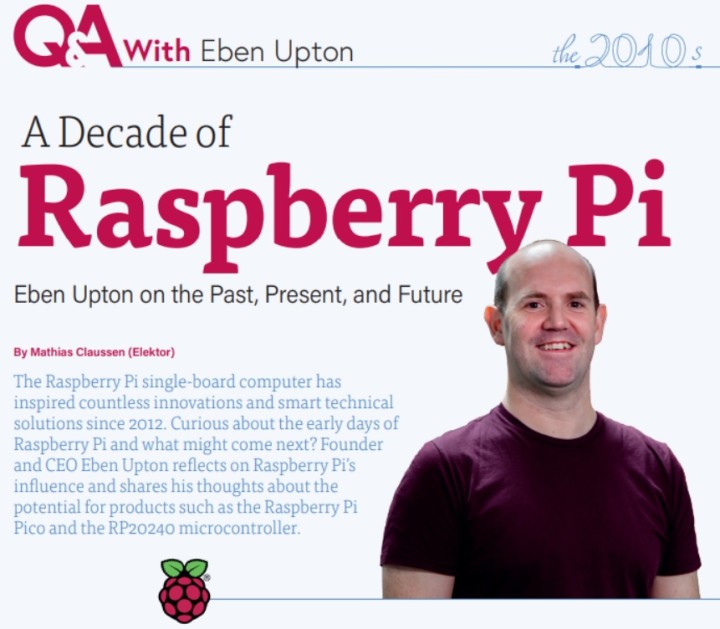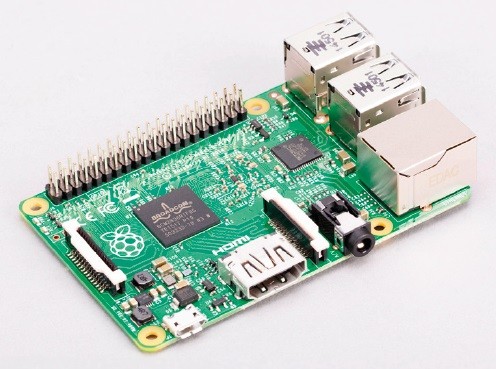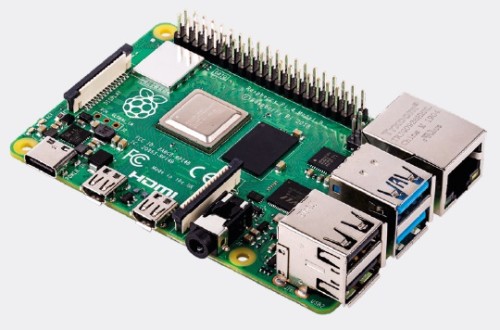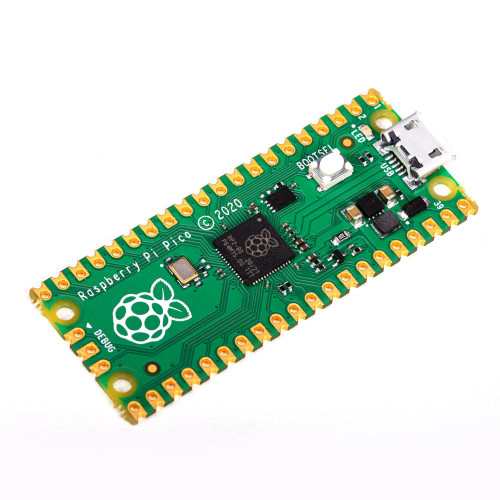Raspberry Pi: A Decade in Review
on

On February 29, 2012, the Raspberry Pi single-board computer (SBC) entered the electronics world with a bang. After selling around 100,000 units in one day, Eben Upton and his innovative team had launched a revolution. During the past decade, makers and pro engineers alike have benefitted from Raspberry Pi's numerous creative products, from the Model B to the low-cost Raspberry Pi Pico microcontroller board. Whether you are Raspberry Pi super fan or just a lover of everything tech, you'll enjoy getting to know a bit more about Raspberry Pi Founder Eben Upton. When Upton spoke with Elektor Senior Engineer Mathias Claussen a few months ago for our 60th anniversary edition, he shared his thoughts about a wide range of topics, from the history of Raspberry Pi to the various challenges associated with designing new solutions.

Why "Raspberry Pi"?
Mathias Claussen: Welcome, Eben. Thanks for having us. I think the Raspberry Pi has been one of the most important technologies of the past decade. What were you thinking about when you were developing the first Raspberry Pi?
Eben Upton: A couple of things. We were very inspired by the 1980s 8-bit computer world. So that’s machines like the BBC Micro, Sinclair Spectrum in the UK, and I’ll guess machines like the Commodore C64 more widely. A little interesting note is that I thought of this as mostly being about computing and software, and was not a believer in putting GPIO access on the board. Pete Lomas, my co-founder, designed the hardware, and he said we should put GPIOs on there. And, of course, that has been a huge part of our success.
Claussen: Why did you choose “raspberry”?
Upton: I quite love them, actually. Some fruits don’t make good pie, so once you decide you want to pull out something "Pi," Raspberry Pi is quite nice. It is quite a sensible name since it makes a nice pie, and it’s one that has not already been used.
Claussen: During the development process, did you ever consider using something different than the Broadcom SoC?
Upton: I was working for Broadcom, so that was an obvious choice. I was involved in designing the chip, and I was a big believer in that. We were originally a microcontroller platform, so actually we were looking at Atmel AVR chips, and we had a prototype.

Raspberry Pi and Linux
Claussen: At the time the Raspberry Pi was in development, was Linux the first choice as an operating system for it?
Upton: We had an earlier iteration of the platform that had more custom operating environments. Obviously, you can’t run Linux on an AVR chip. We actually had an earlier Broadcom design that didn’t have an ARM core, so we couldn’t run Linux, and so we had a pre–Linux Raspberry Pi. But Linux was obviously the choice in terms of its market share, its mind share, the number of people using it, the maturity of its codebase. It was definitely the only feasible choice. Once we had an ARM core, we had a processor that could actually run it.
Claussen: Do you think that the Raspberry Pi helped to spread Linux (GNU Linux) around the world?
Upton: They both helped each other. I think that Linux helped Raspberry Pi and that it makes it really easy to understand what Raspberry Pi is. Raspberry Pi is a Linux PC. It’s not an Intel Linux PC, but it’s a Linux PC — and people understand what it is. What’s interesting, where I use Linux myself on an legacy PC, when I Google for a Linux question, the answer I get is mostly related to a Raspberry Pi. You can see by the amount of Stack Exchange type of content that relates to Raspberry Pi that it has become, outside the cloud and Android, probably the dominant Linux platform. And that’s something we couldn’t have imagined.
Claussen: Do you see, through the Raspberry Pi, an increased acceptance by the industry to use Linux in their devices?
Upton: I don’t know how much influence we had on that. As soon as you offer a platform that has an embedded size, saves costs and energy, but on which you can run Python or GCC, you allow a lot of people who thought they were enterprise software engineers to develop for embedded systems.

Claussen: If the Raspberry Pi would have run another non-Linux-based OS, would Linux have spread as much as it did?
Upton: That’s a really hard question to answer, because I’m not going to make a claim that we propelled Linux into the embedded space. I think we helped, but it would be very popular anyway. Not running Linux would have hindered us more than it would have hindered Linux.
Claussen: For cost reasons, a non-x86 CPU, the ARM core, was used in the first Raspberry Pi. Did you see that as a boost to the ARM architecture and the Linux support for ARM devices?
Upton: I think we made a very substantial contribution in terms of repeatedly telling people that ARM is a real architecture for a PC. It wasn’t when we started, and it is, of course, now. An interesting thing happened last year when we launched the Raspberry Pi 400 and a week later Apple launched the M1-based Macs and MacBooks. It’s nice to tell a story about ARM being a PC architecture for about a decade, launch a product and have that belief confirmed a week later by one of the biggest computer companies in the world (in the form of the ARM-based M1 chip).

Pi for Industry
Claussen: When the Raspberry Pi was developed, its target was the educational market. At what point did you see that it was being used by industry? When did you see it was also used by embedded systems engineers?
Upton: Well, in its first year, it wasn’t really used by students either. It was used by adults, people like us, people who already have skills in this area. Signage was an early industrial application — and we saw by 2013, there was a lot of interest in signage. The kind of broad industrial adoption (industrial automation, industrial control) dates from 2014 onwards. That was when we launched Compute Module 1, the SO-DIMM platform, and also Raspberry 1 B+ and A+, which are the first “modern” Raspberry Pi computers.
Claussen: When you launched the Raspberry Pi Pico, were you focused on education or industrial usage?
Upton: A bit of both, actually. We learned that the Raspberry Pi is a bit too powerful for beginners in education, providing too much flexibility. The Pico is very simple. You plug it into your PC and it has an LED that you can flash. There is an educational focus and the Foundation has done a lot of good work providing educational material.
Obviously, there is an interest in industry, also because it’s our silicon. We are in the process of making chips available to the broad market, so you can get an individual chip from a distributor. There have been no mandates to enter the industry, but the RP2040 is more likely to enter the industry as a single chip than through Picos.

Claussen: You chose ARM architecture for the Raspberry Pi and the Raspberry Pi Pico. But two years ago, the Raspberry Pi Foundation also became a member of RISC-V Foundation. Why?
Upton: We are members of the RISC-V foundation, but all we are doing there is being helpful. It will take a long time for RISC-V to have an impact. It’s not enough to just build the architecture and have the ISA. You also have to have licensable, high quality cores, in a very large performance range.
If you look at ARM, their cores span from the M0+, which is basically the same size which we used in the Pico — which is the same size pretty much as the original ARM 1 from the 1980s — to the Cortex 710 and Cortex X2, which are enormous devices in that kind of Intel performance range. You have cores from ARM which cover that entire space between the two endpoints. So, ARM is a very mature ecosystem on the hardware side, and it is a very mature system on the software side.
Why are we members of the RISC-V foundation? I think RISC-V stands a chance in the microcontroller space, and we have some ideas about what it needs to do in order to succeed. And I think we have always been keen to share those in the RISC-V standardization process. So, it’s not about building a RISC-V-based Raspberry Pi or a RISC-V-based RP2040 or Pico. It’s about a very, very long-term investment for us, our participation. And its great people and great stuff is happening. But it will take time.
Looking Ahead
Claussen: As artificial intelligence (AI) becomes more important, how will Raspberry Pi move toward it in terms of software and maybe even in terms of hardware?
Upton: I think there are two things to talk about. One is that actually shipping powerful general-purpose purpose CPU cores is a good way to do AI — if you don’t want to run a huge model and if you don’t want to do low latency inference. Also, if you don’t care if you need to wait a few seconds to get your inference results, and you don’t care about energy per operation. We see a lot of people do AI on Raspberry Pi 4 just using the cortex A72 cores.
Where is hardware useful? Hardware is useful because you get more average throughput, which is useful for big models, or if you want to run a smaller model more quickly. And it gives you lower energy per inference.
Would we ever put AI on a product? I have a reason why I fear how much a meaningful accelerator costs in terms of silicon area. And if you take that area and apply my area cost matrix to it, you get a device that costs at least tens of cents. If you integrate that into the SoC you are going to add quite a lot of tens of cents to the main platform. We tend not to add things to the core platform that cost tens of cents because there is no room in the budget.
Editor's note: Mathias Claussen's complete interview with Eben Upton appears in Elektor 11/2021.


Discussion (2 comments)